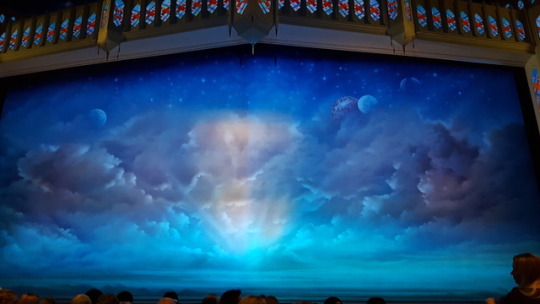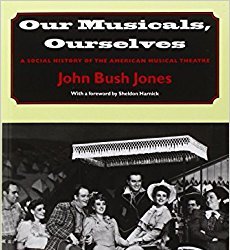Photo

A photo that I took from the theatre’s auditorium at The Book Of Mormon.
0 notes
Photo

A photo that I took outside the Prince of Wales Theatre.
0 notes
Text
Review of 1972: The Future of Sex
1972: The Future of Sex, a play that is based around, quite simply, sex. On the 2nd November, 2016, The Wardrobe Ensemble brought their show to the Atrium theatre for us to watch, during their tour of the show. It explores a group of young adults discovering themselves during a time that has later been described as a revolutionary time for sexuality. As novel Wallowing in Sex: The New Sexual Culture of 1970’s American Television written by Elana Levine quotes, “A new, sexualised popular culture pervaded American life in the 1970’s, and it seemed everyone wanted to be a part of it. Watching a porn film at the local theatre flipping through a sex advice manual in line at the grocery store, dancing the hustle at a glittery discotheque – all were markers of sexual sophistication.” (Levine, 2007) Although this quote directly refers to America, its content can be seen as highly applicable to life in England, where the play was set. The reference to watching a porn film at a theatre can be related closely to The Future of Sex as there is a scene in which one of the female characters takes a trip to an adult shop and watches a porn film, in order to understand what is in store for her. The reference to a “glittery discotheque” can also be closely related to the performance as there was a clear disco theme throughout, with original music played throughout the show, helping to create the disco atmosphere that was so prevalent throughout the 70’s.
What you need to know.
The play follows a group of young adults living in the 70’s, and how the advance in sexuality during this time affects them. It shows how the group of teenagers deal with sexuality in different ways, and how although the 70’s is known as being such a sexually ambiguous time, how teenagers were still extremely uneducated on the matter. One of the stories that takes place throughout the show follows a teenager called Antony, his friends call him Tony, he calls himself, Anton. Anton is a gay teenage boy who’s afraid to come out of his room and show his parents who he really is.
What is the play trying to do?
I believe that the Wardrobe Ensemble’s aim for the piece was to educate their audiences on how sexuality has progressed since 1972 as although many progressions where being made during this time with the introduction of the pill, talks of feminism, and the first gay pride march took place, there is a clear difference in the UK in the modern day in terms of sexuality. (Lowbrow, 2015) The character I mentioned previously, Anton can be seen as a perfect example of this. During the performance we see that his sexuality has been repressed by his parents, and now, because he’s so scared of showing who he really is, he hides in his room so that no one can see him for who he really is. We were lucky enough to take part in a Q and A after the performance which really gave an insight to how the actors felt about their characters and how the performance was put together. When taking part in the Q and A, the cast and production team talked about their feelings on the piece and why they did what they did. They talked about the main themes that were presented during the performance being sexuality and gender, which were prominent throughout. Because the aim of the piece is to educate the audience, the cast and production team had to do their own research to make sure the way in which they were representing the different types of characters, which really came through in the performance and helped to create the authentic emotions needed for each character. For example, the cast explained how they watched Sex Education videos from the 60’s to find out what the characters would have experienced – “they were awful” one of the cast members mentioned.
0 notes
Text
Review of 1972: The Future of Sex
As you can see from the extract from a sexual education video titled Human Growth (1962) published on YouTube by user Daniel Reynolds – there are many clear flaws with the ways in which the narrator describes the changes that a child will go through. For example – he states “they begin to be interested in members of the other sex” which is very clearly not the case with everyone. These are the types of videos that the cast would have watched to gain knowledge on the topic of sexual education in the 60’s then leading to the 70’s, when the piece was set.
They also spoke about the extent of research that they had to do to make sure they succeeded in being able to educate the audience correctly on the topics explored throughout. This research also included interviews with their parents regarding sexuality during the 70’s, as it was difficult for the cast to create authentic emotions without being in the 70’s themselves. The cast revealed that these interviewed rather embarrassing for themselves and their parents, as I can’t imagine many people have sat their parents down and asked them to talk about their sex life and how they felt about sexuality during the 70’s. However embarrassing this proved for the cast, it really added to making sure they succeeded in bringing across their aim, which I believe they did brilliantly.
What stood out as the most effective element
To me, the most effective element during the performance was the narrative style throughout the performance – the ways in which the stories collided and were not just one story after another, the piece would skip from one story to another, keeping the audience interested in what was happening. This was extremely effective to me, as I have found in certain performance that a storyline can sometimes go on for too long, leaving me bored. Because of the fast pace during the Future of Sex, I was kept interested throughout the entire performance.
How could changing things change the outcome?
Leading from what I’ve just discussed, I think that if the different stories throughout the performance were all performed back to back, without switching between different stories throughout, the performance could’ve become rather boring and the pace would have been slowed down quite a lot.
0 notes
Photo

The front page of John Bush Jones’ novel ‘Our Musicals, Ourselves’ (Jones, 2011)
0 notes
Text
Review of Critical Reading on ‘Musical Theatre’
As two of my live theatre reviews are reviews on musical theatre, I thought that I would focus on this type of theatre and find a critical reading on the topic. When looking for sources, I discovered John Bush Jones’ novel, ‘Our Musicals, Ourselves: A Social History of the American Musical Theatre’. (Jones, 2011) Jones has written theatre criticism for a vast amount of journals and newspapers. Some of these include the Boston Herald, the Kansas City Star and the New England Theatre Journal. This shows that he’s clearly a highly thought of journalist within his profession and his sources can be trusted. Published in 2003 by Brandeis University Press, ‘Our Musicals Ourselves’ explores musical theatre and the forms it can come in. For example, chapters include, Musicals of the Roaring Twenties, Black and Jewish Musicals since the 1960’s and Issue-Driven Musicals of the Turbulent Years. It gives a clear insight on the various types of musical theatre, proving that musicals are not always the happy show they are stereotyped to be. The novel shows a full scale of the social history in musical theatre, from Rogers and Hammerstein to Gilbert and Sullivan, leading theatre makers throughout history. He discusses how these musicals engage politics in their performance, and talks of their relevance to society.
The book is written in a vastly approachable way, in chronological order, dating back to the 1920’s. The chapters are easily accessible, and the novel as a whole proved an easy read. Although it refers to a vast amount of types of musical theatre and examples of these, they are highly approachable, and can be read with great ease because of the way that the sections of the book are broken up in clear chapters.
I believe that a novel that goes as deep into the history of musical theatre as this novel does would be best applied to theatre students as university, whether this is for an essay, blog or dissertation. I have come to this conclusion because of the author’s credits outside the novel, as I said earlier; he is clearly trusted in his profession. The source can be considered rather useful in research, because of the depth that it goes into when speaking about the history of musical theatre.
Although the book gives an excellent insight to musical theatre throughout the years, and gives examples of various types of musical theatre, I believe that the ways in which musical theatre has progressed, in terms of taboo topics in theatre becoming far more accepted could have been explored at a deeper level. For example, Spring Awakening. This play was disregarded when first performed in November, 1906 as not acceptable for theatre. However, when the play was adapted into a musical in the 1990’s, and first performed at the Eugene O’Neill Theatre in December 2006, it was a wild success, and has since won many awards and has been propositioned on a film adaptation on the musical. I believe the book would have benefitted from including the progression on musical theatre because it’s such a huge aspect of the history of musical theatre itself.
0 notes
Photo

The Front Page of Anthony Giddens’ novel ‘The Transformation of Intimacy’ (Giddens, 1992)
0 notes
Text
Review of Critical Reading on the topic ‘Sexuality’.
Due to the reason that two of the plays I discussed earlier base themselves primarily off the topic of sexuality – 1972: The Future of Sex and R.U.R, I decided that for my second review of a critical reading I would find a reading that focuses on the broad topic of sexuality. When looking for sources, I found a novel written by Anthony Giddens, ‘The Transformation of Intimacy: Sexuality, Love & Eroticism in Modern Societies.’ First published in 1992, the book explores sexuality in a manner of ways – romantic love, sexual repression, intimacy and the sociological meaning of co-dependence. (Giddens, 1992)
The novel is written in an extremely approachable way, with the preface - The introduction that states what the books aim will be, discussing the style in which the book will be written, in this case, Giddens states that he wanted to “produce a book which would be accessible to most readers who might care to pick it up. So I have avoided technical verbiage whenever possible, even when I stray into intellectual areas of readability I have kept references and footnotes to a minimum.” This proves how approachable the novel is to anyone who wants to read it and that the author has really taken into consideration the variety of people that will be reading the book. Also, the term ‘sexuality’ can be defined in so many different ways, and a novel based around the topic could be rather difficult to follow. However, Giddens always defines what definition of sexuality that he’s talking about, which makes the novel far more approachable to the reader. For example, when Giddens talks of plastic sexuality, he defines it – “Plastic sexuality is decentred sexuality, freed from the needs of reproduction.” The ways in which he defines what type of sexuality he is speaking of makes me as a reader far more interested in the novel when reading.
A novel such as ‘The Transformation of Intimacy’ could be applied with ease to most teachings because of its relaxed style of writing. I think it’s best suited to be applied to teachings at university because of the way that it delves into the topic of sexuality at such a deep level. This source can be considered useful to an extent to a student as it does give a vast amount of information, whilst still keeping a relaxed writing style.
I believe that although the novel goes into such detail on sexuality in a vast manner of ways including examples of other novels that can be examined in order to look at sexuality on a deeper level, the ways in which sexuality and the meanings and history behind this word have changes and progressed over the years would have brought another level to the novel. Although there is mention of how sexuality and the repression of sexuality in women has progressed, I believe that sexuality as an all-round topic has progressed so vastly that the novel as a whole would have benefited from the addition of this.
0 notes
Text
Bibliography
Matilda
Gardner, L. (2011). Matilda - review. [online] the Guardian. Available at: https://www.theguardian.com/stage/2011/nov/25/matilda-review [Accessed 17 Mar. 2017].
Jigsaw-online.com. (2016). Matilda The Musical: In Conversation with Rob Howell | Jigsaw. [online] Available at: http://www.jigsaw-online.com/blog/home/matilda-the-musical.html [Accessed 17 Mar. 2017].
YouTube. (2014). Matilda The Musical - Sydney. [online] Available at: https://www.youtube.com/watch?v=9hQWOfUOtkc [Accessed 17 Mar. 2017].
The Book Of Mormon
Lopez, R. (2011). The Book of Mormon Co-Creator Robert Lopez on His 10-Step Creative Process. [online] Broadway.com. Available at: http://www.broadway.com/buzz/157292/the-book-of-mormon-co-creator-robert-lopez-on-his-10-step-creative-process/ [Accessed 23 Mar. 2017].
Lunn, M. (2015). REVIEW: The Book Of Mormon, Prince Of Wales Theatre. [online] British Theatre. Available at: http://britishtheatre.com/review-the-book-of-mormon-prince-of-wales-theatre-5stars/ [Accessed 23 Mar. 2017].
Reference. (n.d.). What is satire comedy?. [online] Available at: https://www.reference.com/art-literature/satire-comedy-bcfb75bf19057708 [Accessed 23 Mar. 2017].
1972: The Future of Sex
Berkowitz, G. (2015). 1972: The Future of Sex | Review | Theatre | The Stage. [online] The Stage. Available at: https://www.thestage.co.uk/reviews/2015/1972-future-sex/ [Accessed 25 Mar. 2017].
Lowbrow, Y. (2015). The Decade of Decadence: A Quick Look at The Sexual Revolution |. [online] Flashbak. Available at: http://flashbak.com/the-dacade-of-decadence-a-quick-look-at-the-sexual-revolution-29469/[Accessed 27 Mar. 2017].
R.U.R
Freud, S. (2014). Sexuality in the Aetiology of the Neuroses. 1st ed. Read Books Ltd.
Zeitz, J. (n.d.). The Roaring Twenties | The Gilder Lehrman Institute of American History. [online] Gilderlehrman.org. Available at: https://www.gilderlehrman.org/history-by-era/roaring-twenties/essays/roaring-twenties [Accessed 28 Mar. 2017].
Oedipus
S, F. (2010). Aristotle considers Sophocles' Oedipus Rex as the perfect example of tragedy. Explain why.With examples from the play please. | eNotes. [online] eNotes. Available at: https://www.enotes.com/homework-help/aristotle-considers-sophocles-oedipus-king-perfect-154291 [Accessed 28 Mar. 2017].
Critical Reading for Musical Theatre Review
Jones, J. (2011). Our Musicals, Ourselves. 1st ed. Waltham: Brandeis University Press.
Critical Reading for Sexuality Review
Giddens, A. (1992). The Transformation of Intimacy. 1st ed. Blackwell Publishers Ltd.
0 notes
Quote
The theatre is a spiritual and social X-ray of its time.
Stella Adler
0 notes

